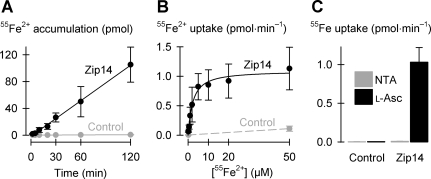Fig. 3.
Zip14 mediates cellular uptake of free iron. A: time course of uptake of 2 μM 55Fe2+ (in the presence of 1 mM l-ascorbic acid) in control oocytes and oocytes expressing Zip14 (n = 8–11 per group). Linear regression of the data for Zip14 (black symbols and lines) yielded a slope of 0.89 ± 0.02 pmol/min and y-intercept at −1.6 ± 0.9 pmol (adjusted r2 = 1.0; P < 0.001). For control (gray symbols and lines), the regression had slope 0.005 ± 0.0002 pmol/min and y-intercept 0.02 ± 0.01 pmol (adjusted r2 = 0.99; P < 0.001). B: 55Fe2+ saturation kinetics in the range 0.2–50 μM Fe2+ in the presence of 1 mM l-ascorbic acid (n = 14–16). Data for Zip14 (black symbols and lines) were fit by Eq. 1 yielding parameters VmaxFe = 1.1 ± 0.1 pmol/min, nHFe = 1.1 ± 0.2, K0.5Fe = 2.3 ± 0.5 μM (adjusted r2 = 0.97, P < 0.001). 55Fe2+ uptake was measured at 0.2 and 50 μM Fe2+ in control oocytes (gray symbols and lines) and joined by a linear fit. C: uptake of 2 μM 55Fe from media containing 1 mM nitrilotriacetic acid (NTA) (in place of l-ascorbic acid, l-Asc) or 1 mM l-ascorbic acid in control oocytes and oocytes expressing Zip14 (n = 11–13). Two-way ANOVA revealed an interaction (P < 0.001); within NTA, Zip14 did not differ from control (unadjusted P = 0.90).

